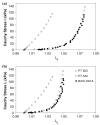The effects of anisotropy on the stress analyses of patient-specific abdominal aortic aneurysms
- PMID: 18398680
- PMCID: PMC2674610
- DOI: 10.1007/s10439-008-9490-3
The effects of anisotropy on the stress analyses of patient-specific abdominal aortic aneurysms
Abstract
The local dilation of the infrarenal abdominal aorta, termed an abdominal aortic aneurysm (AAA), is often times asymptomatic and may eventually result in rupture-an event associated with a significant mortality rate. The estimation of in-vivo stresses within AAAs has been proposed as a useful tool to predict the likelihood of rupture. For the current work, a previously-derived anisotropic relation for the AAA wall was implemented into patient-specific finite element simulations of AAA. There were 35 AAAs simulated in the current work which were broken up into three groups: elective repairs (n = 21), non-ruptured repairs (n = 5), and ruptured repairs (n = 9). Peak stresses and strains were compared using the anisotropic and isotropic constitutive relations. There were significant increases in peak stress when using the anisotropic relationship (p < 0.001), even in the absence of the ILT (p = 0.014). Ruptured AAAs resulted in elevated peak stresses as compared to non-ruptured AAAs when using both the isotropic and anisotropic simulations, however these comparisons did not reach significance (p(ani) = 0.55, p(iso) = 0.73). While neither the isotropic or anisotropic simulations were able to significantly discriminate ruptured vs. non-ruptured AAAs, the lower p-value when using the anisotropic model suggests including it into patient-specific AAAs may help better identify AAAs at high risk.
Figures







References
-
- Chuong CJ, Fung YC. On residual stresses in arteries. J Biomech Eng. 1986;108(2):189–192. [erratum appears in J. Biomech. Eng. 1990 Aug;112(3):249] - PubMed
-
- Crawford CM, Hurtgen-Grace K, et al. Abdominal aortic aneurysm: an illustrated narrative review. J Manipulative Physiol Ther. 2003;26(3):184–195. - PubMed
-
- Delfino A, Stergiopulos N, et al. Residual strain effects on the stress field in a thick wall finite element model of the human carotid bifurcation. J Biomech. 1997;30(8):777–786. - PubMed
-
- Di Martino ES, Guadagni G, et al. Fluid-structure interaction within realistic three-dimensional models of the aneurysmatic aorta as a guidance to assess the risk of rupture of the aneurysm. Med Eng Phys. 2001;23(9):647–655. - PubMed
-
- Di Martino E, Vorp D. Effect of variation in intraluminal thrombus constitutive properties on abdominal aortic aneurysm wall stress. Ann Biomed Eng. 2003;31(7):804–809. - PubMed
Publication types
MeSH terms
Grants and funding
LinkOut - more resources
Full Text Sources

